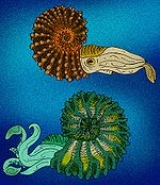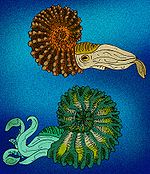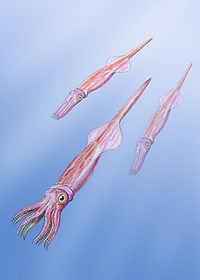
Aalenian
Encyclopedia
The Aalenian ɑː is a subdivision of the Middle Jurassic
epoch
/series
of the geologic timescale that extends from about 175.6 Ma to about 171.6 Ma (million years ago). It was preceded by the Toarcian
and succeeded by the Bajocian
.
, some 70 km east of Stuttgart
in Germany
. The town lies at the southwestern end of the Frankischer Jura
. The name Aalenian was introduced in scientific literature by Swiss
geologist Karl Mayer-Eymar in 1864.
The base of the Aalenian is defined as the place in the stratigraphic column where the ammonite
genus
Leioceras first appears. A global reference profile is located 500 meters north from the village of Fuentelsaz
in the Spanish
province of Guadalajara
. The top of the Aalenian (the base of the Bajocian) is at the first appearance of ammonite genus Hyperlioceras
.
In the Tethys domain
, the Aalenian contains four ammonite biozone
s:
.; 2001: The Global Boundary Stratotype Section and Point (GSSP) of the Toarcian-Aalenian Boundary (Lower-Middle Jurassic), Episodes 24(3): pp 166–175.; 1864: Tableau synchronistique des terrains jurassiques. 1 Tabelle, Zürich. ; 2002: A compendium of fossil marine animal genera (entry on cephalopoda), Bulletin of American Paleontology 364, p 560.
Middle Jurassic
The Middle Jurassic is the second epoch of the Jurassic Period. It lasted from 176-161 million years ago. In European lithostratigraphy, rocks of this Middle Jurassic age are called the Dogger....
epoch
Epoch (geology)
An epoch is a subdivision of the geologic timescale based on rock layering. In order, the higher subdivisions are periods, eras and eons. We are currently living in the Holocene epoch...
/series
Series (stratigraphy)
Series are subdivisions of rock layers made based on the age of the rock and corresponding to the dating system unit called an epoch, both being formally defined international conventions of the geological timescale. A series is therefore a sequence of rock depositions defining a...
of the geologic timescale that extends from about 175.6 Ma to about 171.6 Ma (million years ago). It was preceded by the Toarcian
Toarcian
The Toarcian is, in the ICS' geologic timescale, an age or stage in the Early or Lower Jurassic. It spans the time between 183.0 Ma and 175.6 Ma...
and succeeded by the Bajocian
Bajocian
In the geologic timescale, the Bajocian is an age or stage in the Middle Jurassic. It lasted from approximately 171.6 Ma to around 167.7 Ma . The Bajocian age succeeds the Aalenian age and precedes the Bathonian age....
.
Stratigraphic definitions
The Aalenian takes its name from the town of AalenAalen
Aalen is a city in the German state of Baden-Württemberg, about east of Stuttgart and north of Ulm. It is the seat of the Ostalbkreis district, and its largest city, as well as the largest city within the Ostwürttemberg region. In spatial planning, Aalen is designated a Mittelzentrum...
, some 70 km east of Stuttgart
Stuttgart
Stuttgart is the capital of the state of Baden-Württemberg in southern Germany. The sixth-largest city in Germany, Stuttgart has a population of 600,038 while the metropolitan area has a population of 5.3 million ....
in Germany
Germany
Germany , officially the Federal Republic of Germany , is a federal parliamentary republic in Europe. The country consists of 16 states while the capital and largest city is Berlin. Germany covers an area of 357,021 km2 and has a largely temperate seasonal climate...
. The town lies at the southwestern end of the Frankischer Jura
Jura mountains
The Jura Mountains are a small mountain range located north of the Alps, separating the Rhine and Rhone rivers and forming part of the watershed of each...
. The name Aalenian was introduced in scientific literature by Swiss
Switzerland
Switzerland name of one of the Swiss cantons. ; ; ; or ), in its full name the Swiss Confederation , is a federal republic consisting of 26 cantons, with Bern as the seat of the federal authorities. The country is situated in Western Europe,Or Central Europe depending on the definition....
geologist Karl Mayer-Eymar in 1864.
The base of the Aalenian is defined as the place in the stratigraphic column where the ammonite
Ammonite
Ammonite, as a zoological or paleontological term, refers to any member of the Ammonoidea an extinct subclass within the Molluscan class Cephalopoda which are more closely related to living coleoids Ammonite, as a zoological or paleontological term, refers to any member of the Ammonoidea an extinct...
genus
Genus
In biology, a genus is a low-level taxonomic rank used in the biological classification of living and fossil organisms, which is an example of definition by genus and differentia...
Leioceras first appears. A global reference profile is located 500 meters north from the village of Fuentelsaz
Fuentelsaz
Fuentelsaz is a municipality located in the province of Guadalajara, Castile-La Mancha, Spain. According to the 2004 census , the municipality has a population of 118 inhabitants....
in the Spanish
Spain
Spain , officially the Kingdom of Spain languages]] under the European Charter for Regional or Minority Languages. In each of these, Spain's official name is as follows:;;;;;;), is a country and member state of the European Union located in southwestern Europe on the Iberian Peninsula...
province of Guadalajara
Guadalajara (province)
Guadalajara is a province of central/north-central Spain, in the northern part of the autonomous community of Castile-La Mancha. It is bordered by the provinces of Cuenca, Madrid, Segovia, Soria, Zaragoza, and Teruel...
. The top of the Aalenian (the base of the Bajocian) is at the first appearance of ammonite genus Hyperlioceras
Hyperlioceras
Hyperlioceras is an extinct genus from a well-known class of fossil cephalopods, the ammonites. It lived during the Jurassic Period, which lasted from approximately 200 to 145 million years ago....
.
In the Tethys domain
Tethys Ocean
The Tethys Ocean was an ocean that existed between the continents of Gondwana and Laurasia during the Mesozoic era before the opening of the Indian Ocean.-Modern theory:...
, the Aalenian contains four ammonite biozone
Biozone
Biostratigraphic units or Biozones are intervals of geological strata that are defined on the basis of their characteristic fossil taxa....
s:
- zone of Graphoceras concavumGraphocerasGraphoceras is an extinct genus from a well-known class of fossil cephalopods, the ammonites. It lived during the Jurassic Period, which lasted from approximately 200 to 145 million years ago....
- zone of Brasilia bradfordensis
- zone of Ludwigia murchisonaeLudwigiaLudwigia is a genus of about 75 species of aquatic plants with a cosmopolitan but mainly tropical distribution.Selected species...
- zone of Leioceras opalinum
†Ammonitids
| †Ammonitids of the Aalenian | ||||
|---|---|---|---|---|
| Taxa | Presence | Location | Description | Images |
|
Confirmed. | The only known species in this Alaska Alaska Alaska is the largest state in the United States by area. It is situated in the northwest extremity of the North American continent, with Canada to the east, the Arctic Ocean to the north, and the Pacific Ocean to the west and south, with Russia further west across the Bering Strait... n genus. Abbasites is believed to be ancestral to the ammonite family Otoitidae Otoitidae Otoidtidae: stephanoceratacean ammonitina from the early Middle Jurassic that begin as cadicones but become more planualte with age; derived from the Hammitoceratidae , probably through Erycites by way of Abbasites.... . |
 |
|
|
Ancolioceras Ancolioceras is an extinct genus of cephalopod belonging to the Ammonite subclass.... |
Confirmed. | |||
|
Asthenoceras Asthenoceras is an extinct genus of cephalopod belonging to the Ammonite subclass.... |
Confirmed. | |||
|
Bradfordia Bradfordia is a moderately involute to involute genus included in the ammonoid cephalopod family Oppeliidae, coiled so that the outer whorl encloses most, or much, of the previous, but with a small umbilicus exposing inner whorls. The shell is compressed, whorl height much greater than width,... |
Confirmed. | |||
|
|
Confirmed. | |||
|
|
Confirmed. | |||
|
|
Confirmed. | |||
|
|
Confirmed. | |||
|
|
Confirmed. | |||
|
Euaptetoceras Euaptetoceras is an evolute hammatoceratid ammonite from the lower Middle Jurassic, included in the family Hammatoceratidae and the subfamility Hammatoceratinae. The genus may be a junior synonym for Eudmetoceras of Buckman, 1920.... |
Confirmed. | |||
|
Eudmetoceras Eudmetoceras is an extinct genus from a well-known class of fossil cephalopods, the ammonites. It lived during the Jurassic Period, which lasted from approximately 200 to 145 million years ago.... |
Confirmed. | |||
|
Euhoploceras Euhoploceras is an extinct genus from a well-known class of fossil cephalopods, the ammonites. It lived during the Jurassic Period, which lasted from approximately 200 to 145 million years ago.... |
Confirmed. | |||
|
Fontannesia Fontannesia is an extinct genus from a well-known class of fossil cephalopods, the ammonites. It lived during the Jurassic Period, which lasted from approximately 200 to 145 million years ago.... |
Confirmed. | |||
|
Graphoceras Graphoceras is an extinct genus from a well-known class of fossil cephalopods, the ammonites. It lived during the Jurassic Period, which lasted from approximately 200 to 145 million years ago.... |
Confirmed. | |||
|
Haplopleuroceras Haplopleuroceras is a Middle Jurassic ammonite and likely member of the Hildoceratacean family Sonniniidae with which it shares the same sort of ribbing.... |
Confirmed. | |||
|
Hyperlioceras Hyperlioceras is an extinct genus from a well-known class of fossil cephalopods, the ammonites. It lived during the Jurassic Period, which lasted from approximately 200 to 145 million years ago.... |
Confirmed. | |||
|
|
Confirmed. | |||
|
|
Confirmed. | Synonymous with a modern plant genus Ludwigia Ludwigia is a genus of about 75 species of aquatic plants with a cosmopolitan but mainly tropical distribution.Selected species... . |
||
|
|
Confirmed. | |||
|
Padragosiceras Padragosiceras is an extinct genus from a well-known class of fossil cephalopods, the ammonites. It lived during the Jurassic Period, which lasted from approximately 200 to 145 million years ago.... |
Confirmed. | |||
|
|
Confirmed. | |||
|
|
Confirmed. | |||
|
Praestrigites Praestrigites is a genus from the Strigoceratidae which is included in the ammonitid superfamily, Haplocerataceae.Praestrigites comes from the lower Middle Jurassic and has been found in England, Germany, Switzerland, and Oregon.... |
Confirmed. | |||
|
|
Confirmed. | |||
|
|
Confirmed. | |||
|
|
Confirmed. | |||
|
|
Confirmed. | |||
|
|
Confirmed. | |||
|
|
Confirmed. | |||
|
Stephanoceras Stephanoceras is a Stephanoceratacean genus and type for the Stephanoceratidae, which lived during the Bajocian but is now extinct.... |
Confirmed. | |||
|
|
Confirmed. | |||
|
|
Confirmed. | |||
†Belemnites
| Belemnites of the Aalenian | ||||
|---|---|---|---|---|
| Taxa | Presence | Location | Description | Images |
|
Confirmed. |  |
||
|
Holcobelus Holcobelus is a genus of belemnite, an extinct group of cephalopods.... |
Confirmed. | |||
|
Homaloteuthis Homaloteuthis is a genus of belemnite, an extinct group of cephalopods. Homaloteuthis is a quick moving nektonic carnivore.... |
Confirmed. | |||
|
Megateuthis gigantea Megateuthis gigantea is the largest known belemnite species. The guard of M. gigantea, which has been found in Europe and Asia, can measure up to 46 centimetres in length , giving the living animal an estimated length of 3 metres .... |
Confirmed. | This Eurasia Eurasia Eurasia is a continent or supercontinent comprising the traditional continents of Europe and Asia ; covering about 52,990,000 km2 or about 10.6% of the Earth's surface located primarily in the eastern and northern hemispheres... n species was the largest known Belemnite and could grow to lengths of up to 10 feet. |
||
|
Paramegateuthis Paramegateuthis is a genus of belemnite, an extinct group of cephalopods.... |
Confirmed. | |||
|
Rhabdobelus Rhabdobelus is a genus of belemnite, an extinct group of cephalopods.... |
Confirmed. | |||
|
Sachsibelus Sachsibelus is a genus of belemnite, an extinct group of cephalopods.... |
Confirmed. | |||
†Thalattosuchians
| Thalattosuchia Thalattosuchia Thalattosuchia is the name given to a clade of marine crocodylomorphs from the Early Jurassic to the Early Cretaceous that had a cosmopolitan distribution. They are sometimes colloquially referred to as marine crocodiles or sea crocodiles, though they are not actually members of Crocodilia.The term... of the Aalenian |
||||
|---|---|---|---|---|
| Taxa | Presence | Location | Description | Images |
|
||||
Literature
; 2004: A Geologic Time Scale 2004, Cambridge University PressCambridge University Press
Cambridge University Press is the publishing business of the University of Cambridge. Granted letters patent by Henry VIII in 1534, it is the world's oldest publishing house, and the second largest university press in the world...
.; 2001: The Global Boundary Stratotype Section and Point (GSSP) of the Toarcian-Aalenian Boundary (Lower-Middle Jurassic), Episodes 24(3): pp 166–175.; 1864: Tableau synchronistique des terrains jurassiques. 1 Tabelle, Zürich. ; 2002: A compendium of fossil marine animal genera (entry on cephalopoda), Bulletin of American Paleontology 364, p 560.
External links
- GeoWhen Database - Aalenian
- Lower Jurassic timescale, at the website of the subcommission for stratigraphic information of the ICS
- Stratigraphic chart of the Upper and Lower Jurassic, at the website of Norges Network of offshore records of geology and stratigraphy

